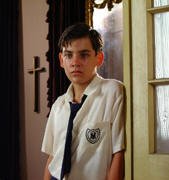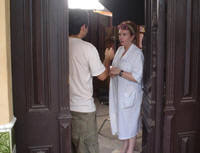That awkward age[*]
Shown in the main Cuban movie theaters, the first feature
by Pavel Giroud is an intimate, contained and sober story of a period.
By: Joel
del Río
Email:
cult@jrebelde.cip.cu
April 22, 2007 00:00:00 GMT
A CubaNews
translation by Ana Portela. Edited by Walter Lippmann. Original:
http://www.juventudrebelde.cu/cultura/2007-04-22/la-edad-de-la-peseta-el-mas-reciente-estreno-cinematografico-cubano/
|
|
|
Pável expertly photographed and directed the
child Ivan Carreira. Photo: Marta María Ramírez |
As in the unforgettable song by Pablo Milanés where the author expresses sorrow over the beautiful and innocent time that disappears without warning. La edad de la peseta, the first feature film by Pavel Giroud is an intimate, contained and sober story of a period, a seemingly “Proustian” recovery of lost time and of distance only conferred through the passage of time and the accumulation of experience. The long-awaited premier of the film (currently showing in movie theaters in the capital) was delayed due to technical problems with the prints. Consequently its theatrical release the was affected by a saturated publicity before its appeared and by the long period between the conclusion of post-production and its presentation on the big screen with multiple premiers which nixed the possibility of one, massive and spectacular premier.
All the technical difficulties, its own retro, intimate, nostalgic, style “where nothing happens” should not be a reason for rejection by the audience. We are observing a valuable, hopeful and highly artistic film as occurred at the Toronto, Havana and Cartagena film festivals. La edad de la peseta is the product of a group of young creators (not only Pavel in direction but also the scriptwriter, Arturo Infante, photographer Luis Najimas, art director Vivian del Valle and editor Lester Hamlet (among others) in a work which perfectly resists the adjective "surprising". It holds up exceptionally well in a context where children do not have many leading roles nor retrospectives free of any form or epic style. And if these exceptional points were not enough, there are not many films so ingeniously photographed with such subtle screen work and edited with such a precise narrative. As required by this delicate story, involving roads into memory and traps of melancholy, there are many subjective cameras, points and counterpoints, with almost constant but never brusque movement of the camera, slow and soft-focus, intensity in the wardrobe and the recreation of a certain music and many sound details and artistic direction which regale us with a sudden image, or sound, the glamorous spirit but also puritanical and the hypocrisy typical of those times.
|
|
|
Although he had appeared in several publicity
spots, La edad ... was the real debut for Ivan
|
|
|
|
An indisputable achievement of the film is the
acting of Mercedes Sampietro, renowned actress in films and the
theater. Below, exchanging opinions with the director during shooting. |
|
|
The action of the film enfolds in the Havana of 1958 where Alicia and her ten-year-old son return to the home of his maternal grandmother who is very strict and jealous of her privacy. The boy tries to adapt to a new environment in the midst of conflicts between mother and grandmother while growing up under the influence of an interest he finds in his grandmother. Some viewers reproach the “lack of action” in the tale. Perhaps the leading roles do not clearly reflect what they want (what they are searching for or trying to achieve). Consequently, the conflicts are expressed with a low intensity in an episodic and cumulative series of events which offer more questions than answers in the characters and ultimate motivations of their personalities. It is not clear, for example, what are the irreconcilable differences between mother with grandmother, the dramatic conflict which holds the whole plot together and is never explained.
But of course, a film does not have to be precise, quintessential and completely understood. Also, the manner in which it is narrated is very important, more than the story itself. That is what happens in La edad de la peseta where talent and creativity are its main implications, more than the recreation of a time and a filial environment, or, in other words, the structure of a tale with classic elements such as suspense or counter-position of the hero and his opponent. This is not to say that the film fails to seduce because of its formalism or what is incidental. What I mean is that the confrontation of the child, pre-adolescent now, with his questions and doubts that surround his adult existence (sex/love, death, profession or vocation, spirit and ethical values, the incurable pain of certain losses) are structured on the screen under the warning of a phrase that the grandmother tells the grandson: “Reality always needs to be retouched” or put another way "The truth requires cosmetics to make it kinder." The film directors has no doubt applyed touches of blusher here and there.
La edad de la peseta is, for our cinema, akin to what Cuban literature meant during the past 30 years in such coming-of-age tales as La caja está cerrado [The Box is Closed] by Anton Arrufat or Un rey en el jardin [A King in the Garden] by Senel Paz. Their distinct elements, encompassed by phrases (rescinding little intrigues which might have been best left in suspense) and because of it certain gaps in the design of some roles. The tone applied to the story – tranquility does not mean boredom when dealing with this film is in harmony with the limits applied to the very dramatic final scenes which demonstrate the reluctance of the director regarding risks of excess and melodrama. Although, in truth, in my opinion, the conclusion of the film strongly demanded a bit of melodrama and opera, tears and emotion. But this is not my film, it is Pavel’s, and his decision is, perhaps more correct since our filmography tends to dramatize metaphors when dealing with migration.
Perhaps I should not conclude this commentary without praising the mastery of the Spanish actors (above all Mercedes Sampietro but also José Ángel Egido), the precision with which Pavel photographed and directed the Ivan Carreira's debut and the very beautiful Carla Paneca, the ability of Susana Tejera to provoke a notable interpretation which often tends to steal the scene from the principal character… To many shining achievements, we can add numerous and succinct promises of greater work for the future; knowing how to reach higher levels of professionalism and intelligence which make La edad de la peseta one of the most suggestive films of Cuban cinema during the years we have gone through in this 21st century.
[*] Or: The silly age. This is a very common phrase in Cuba that denotes the period of adolescence when children are growing into their teens. It is also used during childhood when children are very difficult to manage (around the ages of 7.
La edad de la peseta, el más reciente estreno cinematográfico cubano
 |
| Pável retrató y dirigió con muy buen tino al niño Iván Carreira. Foto: Marta María Ramírez |
 |
| Aunque había intervenido en varios spots publicitarios, La edad... fue el debut real de Iván en la actuación. |
Todos los contratiempos técnicos, el
propio estilo retro nostálgico e intimista de esta película «donde
no pasa nada», no debieran convertirse en argumento para que su
público natural la desdeñara, pues estamos ante un título sin
dudas valioso, alentador y altamente artístico, como fue
reconocido en los festivales de Toronto, La Habana y Cartagena.
La edad de la peseta significa la consagración
de un grupo de jóvenes creadores (no solo Pável en la dirección,
sino también el guionista Arturo Infante, el fotógrafo Luis
Najmías, la directora de arte Vivian del Valle y el editor
Lester Hamlet, entre otros) en una obra que resiste
perfectamente el adjetivo de sorprendente, habida cuenta de que
se yergue excepcional en un contexto donde no abundan los filmes
protagonizados por niños, ni tampoco resultan demasiado
frecuentes las películas retro desvinculadas de toda crítica al
pasado o de cualquier viso épico. Y por si fueran escasas estas
excepcionalidades, debemos reconocer que tampoco nos sobran los
filmes tan ingeniosamente fotografiados, sutilmente puestos en
escena y editados con tal precisión narrativa. Como le cuadra a
esta delicada historia, encauzada por los surcos de la memoria y
las trampas de la melancolía, abundan las cámaras subjetivas,
los picados y contrapicados insinuantes, la movilidad casi
perenne pero nunca brusca de la cámara, los ralentis y fuera de
foco, el regusto en el vestuario y en la selección exacta de las
locaciones, en la recreación de cierta música y en muchos
detalles de sonido y dirección de arte que nos regalan a un
golpe de vista, o de oído, el espíritu glamoroso, pero también
mojigato e hipócrita, de toda una época.
 |
| Un logro indiscutible de la cinta es el desempeño de Mercedes Sampietro, actriz de reconocida trayectoria en el cine y el teatro. Abajo, intercambiando criterios con el director durante el rodaje. |
 |
Pero claro que no todo en una película tiene que ser nítido, quintaesenciado y enteramente comprensible, también puede que importe mucho el cómo se narra; más que el cuento mismo, y eso ocurre con La edad de la peseta, en la cual se aplica todo el talento y la creatividad de sus principales implicados más a la recreación de una época y de un ambiente filial, que a la estructuración de un cuento con elementos clásicos como el suspense o la contraposición del héroe y su oponente. Y ello tampoco quiere decir que la película se deje seducir por el formalismo y lo accesorio. Lo que quiero decir es que el enfrentamiento de un niño, preadolescente ya, con las grandes interrogantes y dudas que rodean la existencia adulta (el sexo/amor, la muerte, la profesión o vocación, el espíritu y los valores éticos, el incurable dolor que generan ciertas pérdidas) se arma en pantalla bajo la admonición de una frase que le dice la abuela al nieto: «La realidad siempre necesita retoques», o dicho de otra manera: la verdad requiere del maquillaje que nos la devuelva más amable, de modo que los realizadores no han dudado en aplicar tandas de colorete aquí o allá.
La edad de la peseta es a nuestro cine lo que significan en la literatura cubana de los últimos 30 años dos relatos de aprendizaje y llegada a la adultez como La caja está cerrada, de Antón Arrufat, o Un rey en el jardín, de Senel Paz. Su aire definidamente introspectivo y evocador está estorbado solamente por la improcedente división de la historia en fragmentos delimitados con frases (anulan la poca intriga que poseen algunos segmentos, y ofrecen respuestas a las interrogantes que mejor hubieran quedado en suspenso) y por ciertas lagunas en el diseño de algunos personajes. El tono apacible de la historia —sosiego no significa nunca aburrimiento cuando se habla de esta película— está en armonía con la contención que le impusieron a las muy dramáticas secuencias finales, cuando se evidencian las reticencias del director respecto a los riesgos del desafuero emotivo o melodramático. Aunque, a decir verdad, de acuerdo con el gusto de este cronista, la culminación de la película pedía a gritos un poco de melodrama y ópera, lágrimas y emoción, pero ya se sabe que no es mi película, sino la de Pável, y su decisión es tal vez la más adecuada, pues nuestro cine suele hiperbolizar el dramatismo a la hora de mostrar la migración.
Injusto concluir el comentario sin elogiar la maestría imponente de los actores españoles (sobre todo de Mercedes Sampietro, pero también de José Ángel Egido), el tino con que Pável retrató y dirigió al debutante Iván Carreira, y a la bellísima Carla Paneca, la habilidad para provocar en Susana Tejera una interpretación más que notable, que muchas veces pugna con robarle al protagonista el centro de la atención... Demasiados logros llamativos, numerosas y sucintas promesas de superiores empeños para el futuro, el saber hacer con altos niveles de profesionalidad e inteligencia, convierten a La edad de la peseta en una de las películas más sugestivas en el cine cubano durante el lustro que llevamos vivido del siglo XXI.